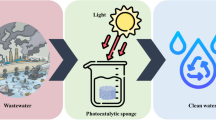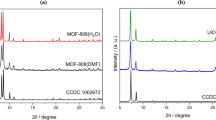Abstract
Simultaneous removal of coexisting metals and dyes from industrial wastewaters is challenging, and the mutual effects behind the co-adsorption of these pollutants remain unclear. Herein, interlayer-expanded MoS2 (IE-MoS2) nanosheets prepared by a one-pot simple and scalable method were tested to simultaneously remove toxic metals and cationic dyes. The adsorption capacities of IE-MoS2 nanosheets were 499, 423, 500, 355, and 276 mg/g for Pb(II), Cu(II), methylene blue, malachite green, and rhodamine B, respectively, in a mono-contaminant system. Interestingly, the sequestration amount of Pb(II) was dependent on the concentrations of dyes in the binary Pb(II)−dye systems, while uptake of cationic dyes was almost not influenced by coexisting Pb(II). The simultaneous adsorption mechanism was further confirmed by spectroscopic methods. The IE-MoS2 nanosheets were easily regenerated and reused for six adsorption−desorption cycles without structure destruction, thus avoiding the potential hazards of nanomaterial to the ecosphere. More interestingly, high-efficiency uptake of Pb(II) from intentionally contaminated natural water and model textile effluent was obtained by using a column filled with IE-MoS2 nanosheets. In summary, IE-MoS2 nanosheets with facile and scalable synthesis method, efficient adsorption performance, and excellent reusability showed potential promise for the integrative treatment of complex wastewater bearing both metals and organic pollutants.







Similar content being viewed by others
References
Ai K, Ruan C, Shen M, Lu L (2016) MoS2 nanosheets with widened interlayer spacing for high-efficiency removal of mercury in aquatic systems. Adv Funct Mater 26:5542–5549
Ali J, Wang H, Ifthikar J, Khan A, Wang T, Zhan K, Shahzad A, Chen Z, Chen Z (2018) Efficient, stable and selective adsorption of heavy metals by thio-functionalized layered double hydroxide in diverse types of water. Chem Eng J 332:387–397
Bellas J, Vázquez E, Beiras R (2001) Toxicity of Hg, Cu, Cd, and Cr on early developmental stages of Ciona intestinalis (Chordata, Ascidiacea) with potential application in marine water quality assessment. Water Res 35:2905–2912
Chen B, Bi H, Ma Q, Tan C, Cheng H, Chen Y, He X, Sun L, Lim T-T, Huang L, Zhang H (2017) Preparation of graphene-MoS2 hybrid aerogels as multifunctional sorbents for water remediation. Sci China Mater 60:1102–1108
Chen B, Chen S, Zhao H, Liu Y, Long F, Pan X (2019a) A versatile β-cyclodextrin and polyethyleneimine bi-functionalized magnetic nanoadsorbent for simultaneous capture of methyl orange and Pb(II) from complex wastewater. Chemosphere 216:605–616
Chen B, Zhao H, Chen S, Long F, Huang B, Yang B, Pan X (2019b) A magnetically recyclable chitosan composite adsorbent functionalized with EDTA for simultaneous capture of anionic dye and heavy metals in complex wastewater. Chem Eng J 356:69–80
Chen W, Lu Z, Xiao B, Gu P, Yao W, Xing J, Asiri AM, Alamry KA, Wang X, Wang S (2019c) Enhanced removal of lead ions from aqueous solution by iron oxide nanomaterials with cobalt and nickel doping. J Clean Prod 211:1250–1258
Chhowalla M, Shin HS, Eda G, Li L-J, Loh KP, Zhang H (2013) The chemistry of two-dimensional layered transition metal dichalcogenide nanosheets. Nat Chem 5:263–275
Deng J, Zhang X, Zeng G, Gong J, Niu Q, Liang J (2013) Simultaneous removal of Cd(II) and ionic dyes from aqueous solution using magnetic graphene oxide nanocomposite as an adsorbent. Chem Eng J 226:189–200
Du Y, Wang J, Zou Y, Yao W, Hou J, Xia L, Peng A, Alsaedi A, Hayat T, Wang X (2017) Synthesis of molybdenum disulfide/reduced graphene oxide composites for effective removal of Pb(II) from aqueous solutions. Sci Bull 62:913–922
Gong S, Zhao G, Lyu P, Sun K (2019) Insights into the intrinsic capacity of interlayer-expanded MoS2 as a Li-ion intercalation host. J Mater Chem A 7:1187–1195
Gu P, Zhang S, Zhang C, Wang X, Khan A, Wen T, Hu B, Alsaedi A, Hayat T, Wang X (2019) Two-dimensional MAX-derived titanate nanostructures for efficient removal of Pb(ii). Dalton Trans 48:2100–2107
Guideline P-BT (2001) OECD guideline for the testing of chemicals. The Hershberger 601:858
Huang Q, Song S, Chen Z, Hu B, Chen J, Wang X (2019) Biochar-based materials and their applications in removal of organic contaminants from wastewater: state-of-the-art review. Biochar 1:45–73
Jia F, Wang Q, Wu J, Li Y, Song S (2017) Two-dimensional molybdenum disulfide as a superb adsorbent for removing Hg2+ from water. ACS Sustain Chem Eng 5:7410–7419
Jia F, Liu C, Yang B, Zhang X, Yi H, Ni J, Song S (2018) Thermal modification of the molybdenum disulfide surface for tremendous improvement of Hg2+ adsorption from aqueous solution. ACS Sustain Chem Eng 6:9065–9073
Jiang H, Ren D, Wang H, Hu Y, Guo S, Yuan H, Hu P, Zhang L, Li C (2015) 2D monolayer MoS2–carbon interoverlapped superstructure: engineering ideal atomic interface for lithium ion storage. Adv Mater 27:3687–3695
Kovalev AI, Wainstein DL, Rashkovskiy AY, Osherov A, Golan Y (2010) Size shift of XPS lines observed from PbS nanocrystals. Surf Interface Anal 42:850–854
Li H, Xie F, Li W, Fahlman BD, Chen M, Li W (2016a) Preparation and adsorption capacity of porous MoS2 nanosheets. RSC Adv 6:105222–105230
Li J, Fan Q, Wu Y, Wang X, Chen C, Tang Z, Wang X (2016b) Magnetic polydopamine decorated with Mg–Al LDH nanoflakes as a novel bio-based adsorbent for simultaneous removal of potentially toxic metals and anionic dyes. J Mater Chem A 4:1737–1746
Li J, Liu Y, Ai Y, Alsaedi A, Hayat T, Wang X (2018) Combined experimental and theoretical investigation on selective removal of mercury ions by metal organic frameworks modified with thiol groups. Chem Eng J 354:790–801
Li Z, Meng X, Zhang Z (2019) Equilibrium and kinetic modelling of adsorption of rhodamine B on MoS2. Mater Res Bull 111:238–244
Liu C, Jia F, Wang Q, Yang B, Song S (2017) Two-dimensional molybdenum disulfide as adsorbent for high-efficient Pb(II) removal from water. Appl Mater Today 9:220–228
Liu X, Ma R, Wang X, Ma Y, Yang Y, Zhuang L, Zhang S, Jehan R, Chen J, Wang X (2019) Graphene oxide-based materials for efficient removal of heavy metal ions from aqueous solution: a review. Environ Pollut 252:62–73
Lokhande RS, Singare PU, Pimple DS (2011) Toxicity study of heavy metals pollutants in waste water effluent samples collected from Taloja industrial estate of Mumbai. India Environ Res 1:13–19
Ma L, Wang Q, Islam SM, Liu Y, Ma S, Kanatzidis MG (2016) Highly selective and efficient removal of heavy metals by layered double hydroxide intercalated with the MoS4 2– ion. J Am Chem Soc 138:2858–2866
Massey AT, Gusain R, Kumari S, Khatri OP (2016) Hierarchical microspheres of MoS2 nanosheets: efficient and regenerative adsorbent for removal of water-soluble dyes. Ind Eng Chem Res 55:7124–7131
Pei H, Wang J, Yang Q, Yang W, Hu N, Suo Y, Zhang D, Li Z, Wang J (2018) Interfacial growth of nitrogen-doped carbon with multi-functional groups on the MoS2 skeleton for efficient Pb(II) removal. Sci Total Environ 631-632:912–920
Qiao X-Q, Hu F-C, Tian F-Y, Hou D-F, Li D-S (2016) Equilibrium and kinetic studies on MB adsorption by ultrathin 2D MoS2 nanosheets. RSC Adv 6:11631–11636
Ramakrishna Matte HSS, Gomathi A, Manna AK, Late DJ, Datta R, Pati SK, Rao CNR (2010) MoS2 and WS2 analogues of graphene. Angew. Chem., Int Ed 49:4059–4062
Ramalingam B, Parandhaman T, Choudhary P, Das SK (2018) Biomaterial functionalized graphene-magnetite nanocomposite: a novel approach for simultaneous removal of anionic dyes and heavy-metal ions. ACS Sustain Chem Eng 6:6328–6341
Song HJ, You S, Jia XH, Yang J (2015) MoS2 nanosheets decorated with magnetic Fe3O4 nanoparticles and their ultrafast adsorption for wastewater treatment. Ceram Int 41:13896–13902
Tong S, Deng H, Wang L, Huang T, Liu S, Wang J (2018) Multi-functional nanohybrid of ultrathin molybdenum disulfide nanosheets decorated with cerium oxide nanoparticles for preferential uptake of lead(II) ions. Chem Eng J 335:22–31
Wang C, Jin J, Sun Y, Yao J, Zhao G, Liu Y (2017) In-situ synthesis and ultrasound enhanced adsorption properties of MoS2/graphene quantum dot nanocomposite. Chem Eng J 327:774–782
Wang HW, Skeldon P, Thompson GE (1997) XPS studies of MoS2 formation from ammonium tetrathiomolybdate solutions. Surf Coat Technol 91:200–207
Wang X, Chen L, Wang L, Fan Q, Pan D, Li J, Chi F, Xie Y, Yu S, Xiao C, Luo F, Wang J, Wang X, Chen C, Wu W, Shi W, Wang S, Wang X (2019) Synthesis of novel nanomaterials and their application in efficient removal of radionuclides. Sci China Chem 62:933–967
Wang Z, Mi B (2017) Environmental applications of 2D molybdenum disulfide (MoS2) nanosheets. Environ Sci Technol 51:8229–8244
Wang Z, Sim A, Urban JJ, Mi B (2018) Removal and recovery of heavy metal ions by two-dimensional MoS2 nanosheets: performance and mechanisms. Environ Sci Technol 52:9741–9748
Xie J, Zhang H, Li S, Wang R, Sun X, Zhou M, Zhou J, Lou XW, Xie Y (2013) Defect-rich MoS2 ultrathin nanosheets with additional active edge sites for enhanced electrocatalytic hydrogen evolution. Adv Mater 25:5807–5813
Xie L, Yu Z, Islam SM, Shi K, Cheng Y, Yuan M, Zhao J, Sun G, Li H, Ma S, Kanatzidis MG (2018) Remarkable acid stability of polypyrrole-MoS4: a highly selective and efficient scavenger of heavy metals over a wide pH range. Adv Funct Mater 28:1800502
Xiong P, Ma R, Sakai N, Nurdiwijayanto L, Sasaki T (2018) Unilamellar metallic MoS2/graphene superlattice for efficient sodium storage and hydrogen evolution. ACS Energy Lett 3:997–1005
Zhang S, Yang H, Huang H, Gao H, Wang X, Cao R, Li J, Xu X, Wang X (2017) Unexpected ultrafast and high adsorption capacity of oxygen vacancy-rich WOx/C nanowire networks for aqueous Pb2+ and methylene blue removal. J Mater Chem A 5:15913–15922
Zhao F, Repo E, Yin D, Meng Y, Jafari S, Sillanpää M (2015) EDTA-cross-linked β-cyclodextrin: an environmentally friendly bifunctional adsorbent for simultaneous adsorption of metals and cationic dyes. Environ Sci Technol 49:10570–10580
Zhao H, Mu X, Zheng C, Liu S, Zhu Y, Gao X, Wu T (2019) Structural defects in 2D MoS2 nanosheets and their roles in the adsorption of airborne elemental mercury. J Hazard Mater 366:240–249
Zhu H, Tan X, Tan L, Chen C, Alharbi NS, Hayat T, Fang M, Wang X (2018) Biochar derived from sawdust embedded with molybdenum disulfide for highly selective removal of Pb2+. ACS Appl Nano Mater 1:2689–2698
Funding
This work was supported by the National Natural Science Foundation of China (21806001 and 31800713). And the CAS Key Laboratory of Photovoltaic and Energy Conservation Materials, Chinese Academy of Sciences is acknowledged.
Author information
Authors and Affiliations
Corresponding authors
Additional information
Responsible editor: Philippe Garrigues
Publisher’s note
Springer Nature remains neutral with regard to jurisdictional claims in published maps and institutional affiliations.
Electronic supplementary material
ESM 1
(DOCX 55 kb)
Rights and permissions
About this article
Cite this article
Wu, Z., Duan, Q., Li, X. et al. Mutual effects behind the simultaneous removal of toxic metals and cationic dyes by interlayer-expanded MoS2 nanosheets. Environ Sci Pollut Res 26, 31344–31353 (2019). https://doi.org/10.1007/s11356-019-06277-6
Received:
Accepted:
Published:
Issue Date:
DOI: https://doi.org/10.1007/s11356-019-06277-6




